Anatomy of low back pain
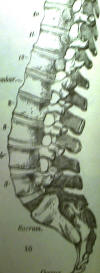
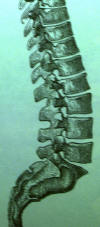
The lumbar spine consists of five lumbar vertebral
bodies. These sit on top of the sacrum, which in turn is above the
coccyx (tailbone). The lumbar spine supports the thoracic spine (which
has twelve vertebral levels), and this in turn supports the cervical spine
(neck), which has seven levels. Finally, the cervical spine supports
the head. It is therefore clear that the lumbar spine supports most of
the weight of the body. It's vertebral bodies are the largest of the
spine, because of the large amount of weight they must bear. vertebral levels), and this in turn supports the cervical spine
(neck), which has seven levels. Finally, the cervical spine supports
the head. It is therefore clear that the lumbar spine supports most of
the weight of the body. It's vertebral bodies are the largest of the
spine, because of the large amount of weight they must bear.

In the above view of a vertebral segment seen from above, the vertebral body is seen as an oval segment of bone.
This will support the bulk of the weight of the body. In between the
vertebral bodies lie the intervertebral disks, which act as shock absorbers
when healthy, but when ruptured into the spinal canal, can cause pressure on
the nerve roots. From the vertebral body arise the pedicles and then
the lamina. These form the covering, and therefore the protection of
the spinal nerves. This triangular space is known as the spinal canal.
The spinous process is seen protruding from the junction of the two laminae,
and is often palpable of thin people. These spinous processes are the
ridges or bumps one feels along the back of the spine. Transverse
processes are seen projecting from the junction of the pedicles and lamina.
Facet joints are joints by which one vertebral body segment is connected
with the next segment.
 Here,
a vertebral body is seen from the side. One can gain an appreciation
for the complexity of the vertebral body and its attachments. Here,
a vertebral body is seen from the side. One can gain an appreciation
for the complexity of the vertebral body and its attachments.
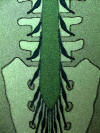
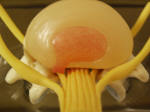 Spinal nerves (seen on left) exit the spinal canal at
every level within the spine. When a herniated disk (right) presses
upon a nerve, one experiences symptoms referable Spinal nerves (seen on left) exit the spinal canal at
every level within the spine. When a herniated disk (right) presses
upon a nerve, one experiences symptoms referable
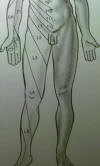 to
the motor and sensory distribution of the nerve. This may amount to an area of
numbness, or weakness of a motor group, or a change in the reflexes
of a certain muscle group. As seen on the right, the skin can be divided into dermatomes.
Each patch of skin has its sensory level determined by the nerve which supplies (innervates) it. to
the motor and sensory distribution of the nerve. This may amount to an area of
numbness, or weakness of a motor group, or a change in the reflexes
of a certain muscle group. As seen on the right, the skin can be divided into dermatomes.
Each patch of skin has its sensory level determined by the nerve which supplies (innervates) it.
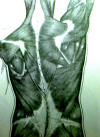
As was seen above, there are many processes protruding
from the vertebral segments. The facet joints are held together with
capsular ligaments. The spinous processes are held together by the
interspinous ligaments. The transverse processes are secured by the
intertransverse ligaments and membrane. There are anterior and
posterior longitudinal ligaments running along the front and bock of the
vertebral bodies, respectively, holding the bodies together. These are
then held in place by the extensive muscular network of the low back,
clearly seen above.
 After the
lumbar nerves leave the spinal canal, they join into larger bundles of
nerves such as the sciatic nerve (from where the term sciatica comes), and
the femoral nerves (seen on left in yellow and green). After the
lumbar nerves leave the spinal canal, they join into larger bundles of
nerves such as the sciatic nerve (from where the term sciatica comes), and
the femoral nerves (seen on left in yellow and green).
|

